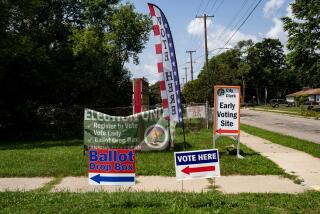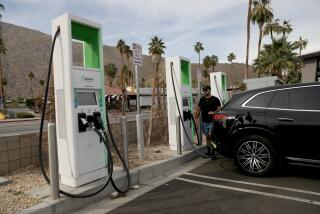Outside auto show, a stalled state
DETROIT -- — General Motors Corp. kicked off this year’s North American International Auto Show with an opulent party in a giant heated tent alongside the Detroit River. Coming on last after several other acts, Michigan’s own Kid Rock took the stage, singing as a pack of runway models escorted a Corvette ZR-1 muscle car down a catwalk.
“Let me tell you about Michigan,” he shouted into the microphone to the crowd of reporters, politicians and society elites.
“We don’t buy [expletive]. . . . We build it!”
What he didn’t say, what no one here wanted to mention, was the obvious: Michigan is building less and less. And all the flashy festivities, paid celebrity photo ops and pomp ahead of the auto show’s public opening Saturday could do little to obscure the grim, almost funereal, atmosphere of a city and state devastated by decades of relentless decline in the automobile industry.
The Big Three U.S. automakers -- GM, Ford Motor Co. and Chrysler -- last year produced 51.1% of the cars sold in the country, their lowest share in history. When GM releases its 2007 global sales numbers this month, it’s expected to cede its title of the world’s leading carmarker, a position it has held since 1931, to Toyota.
With the declines in market share, the companies have shed workers: Of the 400,000 jobs lost in Michigan since 2000, 70% of them were in manufacturing, giving the state the highest unemployment rate in the U.S.
Detroit, once a city of grand skyscrapers and comfortable middle-class neighborhoods, today ranks as the nation’s poorest and most dangerous big city. Art Deco towers stand vacant, and many once-regal neighborhoods look as if they’ve been bombed, with street after street of homes abandoned, burned out and boarded up. By some counts, the Motor City is the area with the highest rate of home foreclosures in the country.
Like the heavy gray skies during the city’s long, cold winter, the feeling of gloom is pervasive here, and Michiganders seem powerless to hide their feelings of desperation, remorse and nostalgia for the glory days.
“The people have the same mentality as the Big Three: denial,” said Cesar Peña, a guitarist and freelance copy machine repairman who lives in Taylor, on the outskirts of Detroit. “Denial of change. Denial of what kind of cars to make. Denial of what kind of jobs to get. We’re in a horrible rut and I don’t see any way out of it.”
Yet buried in all the anger is a resilient stubbornness, a distinctly local brand of conservatism, that says this is all temporary -- that says Detroit will someday, somehow, return to what it once was.
Two-term Mayor Kwame M. Kilpatrick, dressed in a flashy black fedora with a white snap brim for the GM party, said he refuses to give up. “We’re fighting back,” he said.
Visions of change
The city basked in the reopening of the Detroit Institute of Arts in November. Meanwhile, Kilpatrick has taken some extreme measures: To help balance the budget, he reduced the city’s workforce by 25%; this fall, he proposed selling 92 of the city’s parks to increase revenue. Recently, he proposed building a new convention center since Cobo Hall, where the auto show is held, is considered undersized and the automakers have threatened to move their show business out of the city.
His never-say-die attitude was adopted last week by Michigan native Mitt Romney, whose father once headed Detroit-based American Motors Corp. Romney pulled out a victory in the Republican presidential primary Tuesday on the force of television ads mourning a Michigan that once was “the pride of America” but now is in a “one-state recession.” It was a surprisingly negative tone, but it resonated, thanks to Romney’s pledges to make Detroit great once again.
“If I am president,” Romney said in a speech to the Detroit Economic Club, “I will not rest until Michigan is back. Michigan can once again lead the world’s automotive industry.”
It was a promise that none of his chief rivals was willing to make. Campaigning in Pontiac, home to GM’s primary truck plant, John McCain had a different message: “I’ve gotta look you in the eye and tell you that some of those jobs aren’t coming back.”
General Motors, the state’s largest employer, made 3 out of every 5 cars sold in the U.S. in the 1960s; by 1980, that had slipped to 46% and last year to less than 24% for the first time since 1925. This week, GM economists predicted that total industry sales in North America would fall to 15.7 million units in 2008, down from 16.1 million last year, which was already the lowest number since 1998.
GM in the last year has displayed growing interest in producing hybrid vehicles and improving fuel efficiency in the face of soaring gasoline prices and changing consumer tastes. It’s a strategy that worked for Toyota, which now has a profitable hit with the gasoline-electric hybrid Prius.
Pointing fingers
Yet GM has continued its love affair with gas-guzzling light trucks and sport utility vehicles -- its most profitable vehicles -- even in the face of slumping sales of such vehicles (even for Japanese carmakers). Last year, they were down more than 3%, according to Autodata.
Explaining a new investment in an innovative ethanol producer last week, Bob Lutz, GM’s vice chairman, said that “the world we love doesn’t have to change.” With ethanol rather than gasoline, he said, “there’s minimal consumer sacrifice. America could continue to buy the full-size pickup trucks . . . and the V8 engine will be alive and well.”
“There’s a split personality here, between the thirst for horsepower and the responsibility to make fuel-efficient vehicles,” said Mike Jackson, chairman and chief executive of AutoNation, the largest publicly held dealership chain in the country. “And fuel-efficient vehicles have very slim margins.”
Barbara Powers, a saleswoman at Friendly Chrysler Jeep in Warren, Mich., patrols a salesroom decorated with Detroit Redwings hockey jerseys. On the floor are four Jeeps and three Chryslers; only one, a Sebring, gets better than 25 miles per gallon, despite the fact that nearly every customer asks about improved fuel economy, she said.
The only cars that sell these days, she said, are the ones on which Chrysler offers big rebates. “You pretty much focus on that one model,” said Powers, who has worked at this dealership for 16 of the 24 years she’s sold cars. Customers in the town of 140,000 are “very price conscious” these days, she said, and refuse to pay much more than $250 a month for their cars. “I like selling cars, but it’s been tough.”
Powers wonders whether part of the problem might be the United Auto Workers, the powerful union that represents workers at the Big Three and some parts suppliers. This fall, the UAW negotiated new contracts that take many of the employee benefits off the automakers’ books and could save the industry $4 billion a year, according to the Center for Automotive Research.
Still, analysts say, it might be too little too late: The same study suggested the Big Three would save as much as $1,000 per car, a significant improvement but one that still leaves costs above those of foreign carmakers.
“The union served a purpose in the past,” said Powers, who has been trying to sell her condominium in Clinton Township, 30 miles north of Detroit, for two years. “They don’t anymore.”
Others lay blame elsewhere.
At 4:30 p.m. Wednesday, five young men were standing on the grass in front of a house in the Livernois-Fenkell section of Detroit. One who would give only his last name, Turnbow, said his father was a UAW foreman in a Ford plant.
Parked across the street was his car, a late 1990s Ford Taurus with a crusting of ice, rock salt and grime along the doors and quarter panels. On the next block, eight of 16 houses were abandoned, windows smashed or boarded up, front doors wide open.
“It’s not the union’s fault,” said Turnbow, who makes money landscaping when he can find work. “It’s the executives and the politicians. They took our jobs and sent them overseas and all we got were three casinos,” he added, referring to the three gambling palaces built in Detroit recently, including an MGM Grand, which opened in October.
Revenue for the three casinos was $1.3 billion last year, up 2.4% from 2006, which in turn was up 6.1% over 2005. Turnbow attributed the growth to the roughly 80,000 employee buyouts by the Big Three in that time period; some workers got $100,000. “The workers took that money and went right to the tables,” he said. Those that didn’t, he said, left the state.
From July 2006 to July 2007, 30,500 people left Michigan, making it one of only two states to lose population in that period.
One person who was going against the flow was Jim Farley, who in October left his marketing job at Toyota in Torrance for the top marketing and communications job at Ford. Farley has roots in Michigan -- his grandfather worked at the same plant where the Model Awas made -- but he says the move was not an easy one.
“I said no at first,” said Farley, who is credited with the marketing success of Toyota’s Scion brand.
Four months after he moved, his wife is still in Santa Monica. And he says that for all his marketing acumen, getting her excited to move to Detroit has been difficult.
“I miss a lot of things about California,” said Farley, recalling that he used to bike to work daily.
Charged with revitalizing Ford’s image, Farley has his work cut out for him. Last year, Ford’s market share slipped below 15%, according to Autodata, enabling Toyota to surpass it for the first time as the No. 2-selling carmaker in the U.S.
Attitude shift
A block away from the just-finished GM party, Elly Strzalkowski stood on the corner showing off a sleeveless wedding dress on an outdoor set for a local designer, shivering in subzero temperatures.
She models for extra cash; her day job is teaching history at a high school. Her grandfather worked on the Ford line and she recalls when a college friend brought an imported car to campus five or six years ago.
“We had to prank it. We wrapped it in saran wrap, because it was Japanese,” she said. “Now, people only feel obliged to drive American cars if their family has a hand in the industry.”






